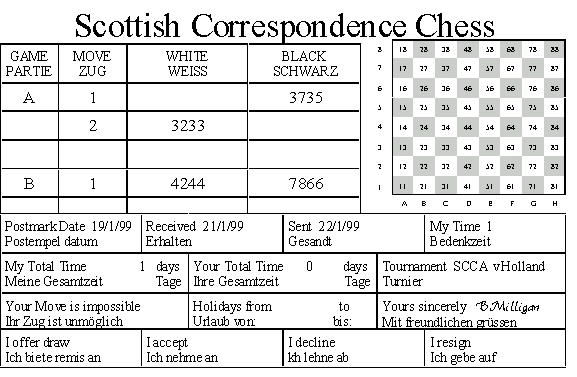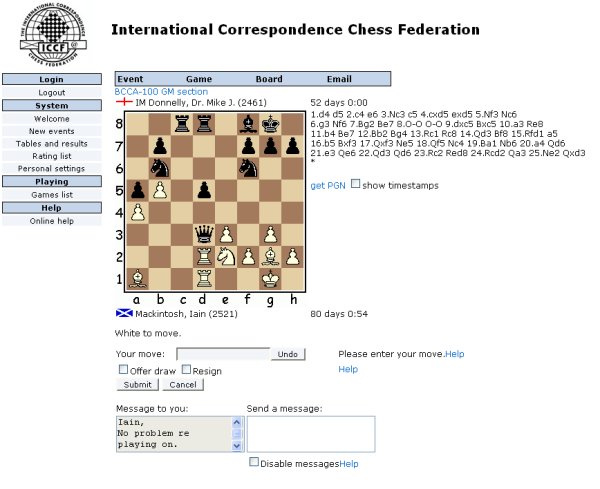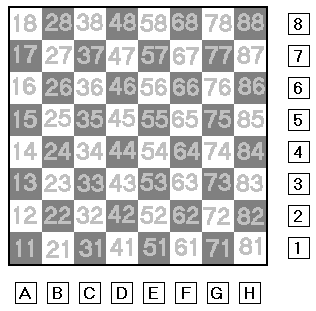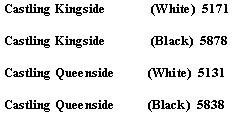 |
How to Play CC |
Last updated 9 December 2006

| This article was written by Bernard Milligan. The following abbreviations are used: SCCA: Scottish Correspondence Chess Association ICCF: International Correspondence Chess Federation OTB: Over The Board |
Introduction
Broadly speaking, Correspondence Chess (CC) is played in exactly the same way as chess is when playing in an over the board (OTB) game. The playing rules are identical. The main difference is that in CC you decide on your move and send that move to your opponent, who then decides on their reply and sends their move back to you. You decide on your next move and send it off. The game continues in this fashion until a result to the game is obtained.
Obviously correspondence games will take far longer to complete than an OTB game, but the advantage is that you can take longer to think about your moves. You should find yourself playing at a higher standard than you may do OTB. The increased playing time should also allow you to experiment with your opening repertoire to a far greater extent than OTB games may permit. You can also get the chance to play people from all over the world who you might otherwise never get the chance to play against.
OTB players are often concerned that Correspondence players may be using Computers to aid them in selecting their moves. In reality there is no way to stop this, and it is true that computer programs are very strong these days. Yet it is surprising how many average strength players have managed to notch up wins against them. I still believe that the vast majority of players use their own minds to select their moves. You shouldn't let the possibility of computer use scare you. In the end we play chess because we enjoy it and because it is a difficult game to master. If you're looking for quality games without the need to travel to clubs or congresses then CC will be ideal for you.
This information booklet will not give an in-depth guide to CC, but will rather concentrate on the basics which most new correspondence players will want to know when they first begin to enjoy this fascinating way of playing the game. If you can't find the answer to a particular question in this booklet, then contact the Tournament Director (TD) of the competition you are playing in, or any other SCCA official, for advice. All will be more than happy to give advice and help, and sort out any problems you may be experiencing.
Etiquette
The vast majority of Correspondence games are played without any real problems. This is because there is a general form of etiquette which is observed between players. If players are polite and courteous with each other then there are less likely to be any disputes.
Time controls for games are set to allow tournaments to end at specific times, but they also ensure that moves are sent back and forth at a reasonable rate. Opponents can start to worry if they haven't heard from you for some time. If you're taking a period of leave, inform your opponents beforehand rather than have them wonder why they haven't heard from you for several weeks. If you haven't heard from an opponent, then drop them a note repeating your last move. It's possible that they have replied but the card has gone astray in the post, or the email has been gobbled up by a spam filter. Often all it takes to get a game moving again is a polite reminder.
Obviously if games are played over a long period there will be times when, due to other circumstances, we may not be able to reply as quickly as in the past.
If problems arise and you can't reply then drop your opponent a short note to keep them informed. If you can't do that then give the TD a call and ask them if they can contact your opponents for you. This can also have the advantage that if the TD feels there are extenuating circumstances they may give you additional leave to cover your current difficulties, and this may help you avoid losing a game on time.
If you haven't heard from your opponent and your repeat moves have failed to get a response, then contact the TD immediately. They will then try to check out any problems and get the game moving again.
Please always use new envelopes when sending postal moves. Re-used envelopes can cause delays in the post and this only slows the whole game down. Your opponent also needs to check the postmark of your moves, and envelopes with multiple postmarks can make this impossible.
All of this may seem common sense but it is worth mentioning as basic courtesy does avoid problems and fosters good relations which will greatly enhance your enjoyment of your games.
General Correspondence Problems
Problems do occasionally occur in correspondence chess, but no more often than when playing OTB chess. In an OTB tournament if you are unsure of something, you would simply ask the Tournament Arbiter for advice. In Correspondence Chess the Tournament Arbiter is usually called the Tournament Director (TD) and obviously they have to be contacted by different means to obtain advice.
In some instances you will have a telephone number for direct contact, but in other instances you may have to write or email directly (or, on the webserver, use the special communications options on the menu) to the TD for any advice required. In any case, this should not pose a problem as the longer time controls mean that you should have plenty of spare time available to clarify any point before playing your next move.
Tournament Types
SCCA tournaments have been restructured from 2007, and it is now possible for players to choose any of the three main playing modes (postal, email and webserver) in most events.
A full explanation of the events available to members can be found in Tournaments.
Playing Modes
Postal
There are two main methods of playing by post:
- Scorecards
These cards usually contain space for two games to be played at the same time, and have two boxes which contain the name and address of each player. The cards are folded and placed in window envelopes so that the name and address of the player receiving the moves shows through the window. The card is used throughout the duration of the games, but it is advisable to change the window envelope on each posting. If you want to offer your opponent a conditional move (or moves), it is best to insert a note inside the window envelope rather than write on the scorecard itself.
When filling in the card (Diagram 1) you need to record details of the date on which you received your opponent's move, the date you sent your reply, the total time taken by you so far, and your move. Each card has space for two games to be played simultaneously. This is because in some tournaments you will have two games against each opponent, one with the White pieces and one with the Black pieces. For simplicity's sake I have only filled in the details for one game.
The first boxes to be filled on the card are the event (tournament), start date (when the tournament is designated to begin) and adjudication date (when the tournament is designated to end). In the example card this is the Premiers beginning on 17/1/99 and ending on 31/10/99.
The next part to be filled in is the players name. In this instance Alan Brown is playing with the White pieces and Bernard Milligan is playing with the black pieces.
The dates section for each player has three columns under it. R, S and T. In the R column you write the date on which you received the move from your opponent. In the S column you write the date on which you send your reply to your opponent (this must coincide with the date with which the envelope will be postmarked). In the T column you write the total number of days (reflection time) that you have taken for all your moves to date. You would then write your move under the White or Black column, depending upon which colour you are playing with.
Diagram 1
SCOTTISH CORRESPONDENCE CHESS ASSOCIATION EVENT SCCA Premiers START DATE 17/1/99 ADJUDICATION DATE 31/10/99 GAME A GAME B Alan Brown Bernard Milligan DATES White Black DATES DATES White Black DATES R S T R S T R S T R S T 17/1 17/1 0 e4 c5 19/1 19/1 0 1 21/1 22/1 1 c3 d5 25/1 25/1 0 2 28/1 29/1 2 exd5 Qxd5 2/2 2/2 0 3 5/2 5/2 2 d4 Nc6 8/2 8/2 0 4 11/2 11/2 2 Nf3 Nf6 13/2 13/2 0 5 16/2 17/2 3 Be2 6 7 8 In calculating your reflection time if you receive a move and post back your reply the same day then you have taken zero days for that move. If you post back your reply the following day then you have taken one day for that move. Similarly if you post back your move three days after receiving the move then you have taken three days for that move.
Looking at Diagram 1, the game between Alan Brown and Bernard Milligan has gone as follows:
The Premiers tournament began on 17/1/99. Alan posted his first move, 1.e4 on the 17th and therefore had taken 0 days reflection time. His card was filled in e4, 17/1, 17/1, 0, e4. Bernard received Alan's move on the 19th and sent his reply, 1...c5, on the same day having used 0 days reflection time. His part of the card was filled in c5, 19/1, 19/1, 0. Alan received this move on the 21st and replied 2.c3 on the 22nd having taken 1 day to think about his move. Alan's total time taken was therefore 1 day plus the total from the previous box in the T column (0 days), giving a total of 1 days reflection time in the T column at that move. Looking at Alan's next move he received the move from Bernard on the 28th and replied 3.exd5 on the 29th again having taken 1 day to think about his move. Alan's total time taken was therefore 1 day plus the total from the previous box in the T column (1 day), giving a total of 2 days reflection time in the T column at that move.
As shown, it is not difficult to record the game and keep track of its progress. Different tournaments will have different time controls with a varying number of moves having to be played within a certain number of days. After joining the SCCA you should become familiar with the range of Tournaments and the Rules of Play which govern them.
A common example is a time control where a player must make 10 moves within 20 days. The 20 days refer to the players reflection time and will not include any time during which the playing card is in the post or with your opponent. In Diagram 1 Alan has used 3 days for 6 moves so he will still have 17 days to make another 4 moves before reaching the first time control at move ten. The next time control would be at move 20, at which point he must not have taken more than 40 days total reflection time.
Play is allowed to continue up to the adjudication date specified for the tournament. The game is over once one player has won or both players have agreed a draw. If a result has not been reached by the end of the tournament and both players cannot agree a result, then the game is submitted for adjudication. This procedure is also specified in more detail in the Rules of Play.
- Postcards
International chess postcards can be purchased from the SCCA and most chess stockists, and are used for both domestic and international play. A postcard only lasts for one move (or one pair of moves) and, because the game score isn't being exchanged between the players each time, you are required to confirm your opponent's last move(s) as well as write down your next move(s). Conditional moves are also written on the card, so you have to think carefully in order to manage the space available, particularly if you are playing two games against the same opponent.
Diagram 2

Diagram 2 shows how a postcard is filled in. In this instance two games are being played against the same opponent. Players are required to provide the date they received their opponent's move, the date of their reply, their reflection time for that move, their total reflection time for the game, their opponents total reflection time and their move for each game.
In email games you must send your opponent exactly the same information as required when sending moves for postal games, but here there are no pre-formatted scorecards or postcards.
Email conventions range from the minimalist to the elaborate. The minimum requirement (for each game contained in the email) is that you repeat your opponent's last move, play your move, and keep a record of the time. The information shown on the postcard in Diagram 2 is sufficient, but it is up to you how you type in the details and format them within your chosen email software. It is best to use a widely available, standard font such as Arial or Courier New.
ICCF has a preferred template for international play (though it is not enforced), and Diagram 3 illustrates this below. The idea here is similar to the original postal scorecard, where the full game score is exchanged each time (so your emails keep getting bigger). Also shown below is the use of a secondary notation, which can be useful to avoid ambiguity, e.g. if you are new to the international numeric notation and not confident of getting it right.
Diagram 3
[Header - event and players necessary, rest optional] [Event "BCCA-100 GM section"] [Start Date "2006.10.25"] [White "Williams, Christopher C."] [Black "Mackintosh, Iain"] [Result "*"] [WhiteElo "2498"] [BlackElo "2521"] |
||||||||
[Secondary algebraic notation - optional] 1.d4 Nf6 2.Nf3 e6 3.Bg5 c5 4.e3 Be7 * |
||||||||
| Williams | Move | White | Black | Mackintosh | ||||
| R | S | T | R | S | T | |||
| 24/10 | 0/0 | 1. | 4244 | 7866 | 24/10 | 25/10 | 0/0 | |
| 26/10 | 27/10 | 1/1 | 2. | 7163 | 5756 | 28/10 | 29/10 | 1/1 |
| 29/10 | 30/10 | 1/2 | 3. | 3175 | 3735 | 01/11 | 03/11 | 2/3 |
| 04/11 | 06/11 | 2/3 | 4. | 5253 | 6857 | 06/11 | 06/11 | 0/3 |
Basic email formatting (plain text) makes it awkward to format the game score into columns. The simplest method is to use spaces rather than tabs between each column of information. Advanced email formatting (html) allows you to insert tabs and tables, but not everyone will be able to receive your artwork, so simplest is usually best.
If you are playing more than one game, just start a new header below the first game, and use the same format for second (and subsequent) games.
International email rules allow a one day transmission time, which many players feel is unnecessary (it is known as the "phoney day" in CC circles). So, you are allowed to claim zero reflection time if you respond within 48 hours of receipt rather than 24. Many players (as in the example here) prefer to ignore this, and charge reflection time on the usual 24-hour basis.
Strangely, despite the fact that E-mail games may for example allow for an average of 4-6 days reflection time per move, many players using this method of play tend to get into the habit of sending moves on a daily basis. If that suits you fine, then ok, but don't feel pressurised to do so just because your opponent does. You are entitled to use all your available thinking time if you so wish. There are very few things worse than losing a game because you have made a series of weak moves due to insufficient analysis. Use your time wisely and you will enjoy your game more.
Webserver
The ICCF webserver has revolutionised CC, doing away with most the administrative chores faced by players who play postal or email chess. The software informs players by email when the TD has scheduled a game to start. The player with the white pieces logs in to the webserver (players need an id and password to play) and plays a move, usually by dragging a piece with the mouse to its destination square. The software shows the position on the board after this move, and the player may cancel it (if a mistake has been made or a better move is apparent). Once the player is happy with the move, the Submit button is clicked and the move is finally made.
The opponent receives an email notification that a move has been made and considers what reply to make - this can be done without logging in to the webserver. Once the reply has been decided, the opponent logs in to the webserver and plays a move in the same way as the first player. A further email is generated indicating a move has been made, and the first player is to play, and so on until the game reaches a conclusion. The webserver recognises mates, and gives options for players to resign or agree draws.
During all this, the webserver has recorded all the moves, has kept a record of the dates and times they were made, has calculated the overall time used by each player, and has indicated how many days each player has left before the next time control. Players are able to download pgn files containing their game scores at any time. The webserver automatically updates the tournament cross-table when the result of the game is decided.
The webserver is also able to book holidays for players, allows players to communicate with TDs and each other via message boxes on the same screen as the game board. It keeps records of all tournaments and games a player has entered.

If you are new to webserver, it is possible to visit the ICCF webserver and browse the events and games which are available to the public. There is an excellent tutorial for first-time users which can be located at Help/Online Help/Tutorial via the home page menu.
Move Notation
Algebraic
Algebraic notation is today's universally accepted chess language. Though there are other styles, algebraic has been accepted as the standard by FIDE, which governs all world-class chess competitions.
| Piece | Notation | Board |
|---|---|---|
 |
K |  |
 |
Q | |
 |
R | |
 |
B | |
 |
N | |
 |
(none) |
To write standard algebraic notation you must indicate the piece and the square it is moving to. Notice how each piece is abbreviated with a single letter except the pawn. If no piece is named it is assumed that a pawn move is made. Notice also how the Knight is abbreviated with an "N" not "Kt" or "K".
To write extended algebraic notation, you first write the start square of the piece and then its destination. This is more accurate, but is seldom used as the standard shorthand method is quicker.
| Examples | |
|---|---|
| e4 | pawn moves to square e4 |
| e2-e4 | extended notation of pawn moves to square e4 |
| Nf3 | knight moves to square f3 (may imply a capture) |
| Nxf3 | knight moves to square f3 and explicitly captures the piece on that square |
| Ndf3 | two knights can move to square f3, so the one which moves starts from the d-file |
| Nd4f3 | two knights (at d2 and d4) can move to square f3, so the one which moves starts from the square d4 |
| 0-0 | castles king-side |
| 0-0-0 | castles queen-side |
When playing international chess, English algebraic is the convention used by most players (and adopted by the ICCF webserver). However, your opponents may forget and lapse into the notation used in their own language. Fortunately, everyone numbers the board squares in the same way, so you only have to remember the piece notations. Here are the most common languages:
| Piece | English | French | German | Italian | Magyar | Spanish |
|---|---|---|---|---|---|---|
 |
K king |
R roi |
K könig |
R re |
K király |
R rey |
 |
Q queen |
D dame |
D dame |
D donna |
V vezér |
D dama |
 |
R rook |
T tour |
T turm |
T torre |
B bástya |
T torre |
 |
B bishop |
F fou |
L läufer |
A alfiere |
F futár |
A alfil |
 |
N knight |
C cavalier |
S springer |
C cavallo |
H huszár |
C caballo |
 |
(none) pawn |
(none) pion |
(none) bauer |
(none) pedone |
(none) gyalog |
(none) peón |
International Numeric
 |
 |
ICCF uses an international numeric notation to surmount language barriers. Moves in domestic CC are usually sent in standard algebraic notation (e.g. 1.d4 Nf6) or, to avoid ambiguity, the long form that specifies the start square also (1.d2-d4 Ng8-f6).
However, moves in international competitions should normally be sent in the ICCF's numeric notation and it can also be used in email play with opponents from non-English speaking countries if you wish. Newcomers to international play should take care with it.
The grid above, published with the ICCF rules, is the key to numeric notation. It corresponds to long algebraic, but only the squares are stated; there are no initial letters for pieces. each square is identified by a two-figure code number. Moves are indicated by putting first the square of origin and then square of destination, producing a four figure number for each move. There are no special indications for check or en passant, the above number being sufficient. Castling is indicated by the King move alone.
Hence any move consists of four figures except when promoting a pawn.
This is indicated as above, i.e. by stating the square of origin and the square of destination but by adding, as a fifth figure, the code number corresponding to the piece into which the pawn is promoted, viz:
1=Queen; 2=Rook; 3=Bishop; 4=Knight.
A game, for example, beginning 1.e4 e5 2.Nf3 Nc6 3.Bc4 would be recorded 1.5254 5755 2.7163 2836 3.6134 in International Numeric Notation.